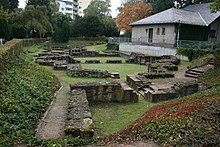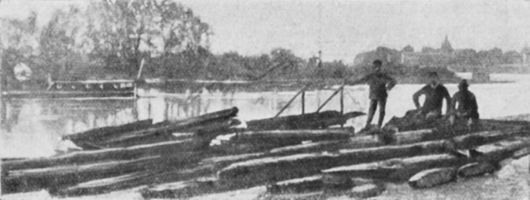Salisberg Castle
| Salisberg Castle | |
|---|---|
| limes | ORL NN ( RLK ) |
| Route (RLK) | Upper German Limes, route 5 (eastern weather route) |
| Dating (occupancy) | approx. 92–110 AD (Trajan period) |
| Type | unknown auxiliary force unit (number or cohort) |
| size | largely unknown |
| Construction | Wood and earth fort |
| State of preservation | Ground monument, not visible |
| place | Hanau - Kesselstadt |
| Geographical location | 50 ° 8 '6.9 " N , 8 ° 54' 2.7" E |
| height | 104 m above sea level NHN |
Fort Salisberg is a former Roman fort in the area of the Wetterau line of the Upper German-Raetian Limes . It is located northeast of the center of Hanau - Kesselstadt in the Main-Kinzig district in Hesse . The fort seems to have functionally replaced the nearby Kesselstadt fort . It belongs to an earlier Limes line from Nidderau -Heldenbergen via Mittelbuchen to the Main near Hanau, as has been proven by new discoveries of two Roman forts near Hanau-Mittelbuchen .
location
The fort was located on a slight elevation above the waters of the Salisbach (tributary of the Krebsbach , east), the Kinzig (south) and the Lache (also Weihergraben) to the west, over which the Salisberg is tongue-shaped from the north by about three to rises four meters. The area of the fort was built on extensively by the Kaiser brewery in the 19th century , and the plant's deep ice cellars in particular destroyed significant parts of the archaeological substance. The northern half of the fort fell victim to a high-rise building on Salisweg in the 1970s. Today there is a green area on the southern part. The Salisweg runs right through the fort area. To the southwest in the Salisbach area, the last remnants of the brewery are the Kaiserteiche ponds , which were created to break the ice in winter.
A Roman road coming from the NNW direction formed an axis of the fort. Due to the poorly documented and researchable section of the archaeological findings, it remains unclear which one. It crossed the Main south of the fort with a bridge, of which stumps were found in 1886 and 1893 250 m above the mouth of the Kinzig near the present day harbor basin of the Waterways and Shipping Authority. Engineer tools, military equipment and over 70 coins thrown into the river as victims were also discovered during dredging. South of the Main, the road connected the settlement with areas of the Civitas Auderiensium and its main town, Dieburg . A small settlement developed on the Mainspitze - just like south of the fort - which continued to exist even after the soldiers had left.
history
The much smaller Salisberg fort seems to have been built as the successor to the larger Kesselstädter fort. Since only a few remains of the Salisberg fort could be archaeologically examined, only the large number of stamped bricks from the bathing building (more than 250 pieces) and a few ceramic finds can be used for dating. Among other things, they contained brick stamps of the 14th , 21st and 22nd Legion . According to this, an older bath may have been built with recycled pieces from the Kesselstadt fort, which came from the 14th Legion, who withdrew from Mainz in 92 AD . The most recent and very numerous pieces, mainly from the brick production of the 22nd Legion, do not extend beyond the Trajan period. A similar construction and composition of the brick finds is available from the nearby Hainstadt fort south of the Main, which presumably dates to the same time as Salisberg.
A more recent evaluation of the coin series largely supports the early dating made on the basis of the brick finds. It suggests an occupation of the area around 100 AD.
The unit stationed in the fort remains unknown. Due to the finds, it was probably withdrawn around 110 AD, and the fort was then abandoned. Its function was taken over by the forts of the younger Limes line at Rückingen and Großkrotzenburg . Another fort in the Hanau district is the Neuwirtshaus small fort .
investment
Only a small part of the fort has been documented due to the later overbuilding. Larger excavations have mainly taken place in the fort bath and in the vicus to the south .
Fort
From the entire fort, only a 70 m long section with a pointed ditch in the southeast corner and a 7.8 m wide gate break east of the brewery site could be exposed. No plans are known of the excavations carried out by Heinrich Ricken between 1931 and 1935. Today's routes still largely follow this course.
Fort bath
The fort bath, which was excavated by Georg Wolff before and after the First World War , is better documented . A major exposure and conservation took place in 1989; the facility is located in the Kesselstädter cemetery and can be visited there.
A distinction must be made between an older and a younger bathroom, of which only a five by six meter hypocausted room has been exposed. The younger bath, with a length of 43 meters, corresponds to many military baths on the Limes. Due to the size of the younger baths, there are speculations about the stationing of a cohort or an extension of the fort, but this cannot be proven in more detail. Finds of painted fragments of wall plaster from the caldarium show that at least this central room was colored inside.

Vicus
To the south of the fort, in an area where prehistoric finds were also made, a civil settlement was formed, in which the associated traders and traders settled. The settlement continued to exist even after the troops withdrew due to the favorable traffic situation. It was only abandoned in the 3rd century AD in the time of the Limes Falls. Excavations had already taken place in the area under Georg Wolff and Heinrich Ricken, further investigations by the Hanau History Association followed under Hugo Birkner after the Second World War , in 1978/79 and 1986 by Peter Jüngling . Despite this work, the interpretation of the findings as villa rustica , vicus or rest station remained unclear . Further excavations due to the development of a property on Köppelweg led to one of the largest excavations of the Hanau History Association, also under the direction of Peter Jüngling, from 1992 to 1997. Uncovered strip houses make the interpretation as vicus more likely. Significant finds include a Roman coin treasure, which is now in the Museum Schloss Steinheim , as well as the oldest document dated to the day in Germany, a receipt made in Mainz, issued on April 5, 130 AD.
Monument protection and remains
The Salisberg Fort is a ground monument under the Hessian Monument Protection Act . Investigations and targeted collection of finds are subject to approval, random finds must be reported to the monument authorities.
The finds from recent excavations, including the coin treasure, are exhibited in the Museum Schloss Steinheim in Hanau-Steinheim .
See also
literature
- Dietwulf Baatz : The Roman Limes. Archaeological excursions between the Rhine and the Danube. 4th edition. Gebr. Mann, Berlin 2000, ISBN 3-7861-2347-0 , p. 171.
- Wolfgang Czysz : Hanau-Kesselstadt. Rom. Kesselstadt and Salisberg castles. In: Dietwulf Baatz and Fritz-Rudolf Herrmann (eds.): The Romans in Hessen³ . Licensed edition of the 1989 edition, Nikol, Hamburg 2002, ISBN 3-933203-58-9 , pp. 334–336.
- Wolfgang Czysz: Excavations in the Kesselstadt fort in Hanau, Main-Kinzig district. In: Find reports from Hessen 17/18, 1977/78 (1980) pp. 165–181.
- Ernst Fabricius , The Upper Germanic-Raetian Limes of the Roemerreiches (ORL) Dept. A Route 4-5 (1936), pp. 175–177.
- Peter Jüngling : Hanau-Kesselstadt. Roman military installations and vicus . In: Guide to archaeological monuments in Germany 27. Hanau and the Main-Kinzig-Kreis , Theiss-Verlag (Stuttgart 1994) pp. 174–178. ISBN 3-8062-1119-1
- Simon Sulk: The Roman Limes on the Hanauer Salisberg - Kesselstadt in the border area. The archaeological research for over 180 years . In: New Magazine for Hanau History 2016, pp. 3–17.
- Peter Jüngling: From Barter to Money Management - A Brief Overview of the Early History of Money . In: Stadtzeit 4 (Hanau 2001), ISBN 3-9806988-3-1 , pp. 9-14.
- Peter Jüngling: “Pecunia olet” '(“and it stank”) - an unusual treasure find on Hanauer Salisweg . In: Stadtzeit 4 (Hanau 2001), ISBN 3-9806988-3-1 , pp. 15-19.
- Peter Jüngling: The time of the Romans . In: Stadtzeit 7 Kesselstadt - Spotlights on two millennia - 950 years of first mention of Kesselstadt (Hanau 2009), ISBN 978-3-937774-73-2 , pp. 14-21.
- Peter Jüngling: Roman inscriptions from Kesselstadt - or what an old piece of wood tells us . City time 7 Kesselstadt - spotlights on two millennia - 950 years of first mention of Kesselstadt (Hanau 2009), ISBN 978-3-937774-73-2 , pp. 14-21.
- Ferdinand Kutsch : Hanau. Part 2 , Frankfurt am Main 1926 (= catalogs of West and South German antiquity collections 5) pp. 93–106.
- Barbara Oldenstein-Pferdehirt : The Roman auxiliary troops north of the Main. Research on the Upper Germanic Army I. In: Yearbook of the Römisch-Germanisches Zentralmuseums 30, 1983, pp. 303–348, especially p. 333.
- Marcus Reuter : A rare find from a Roman well: preliminary report on the wooden writing tablet with receipt from April 5, 130 AD from Hanau-Salisberg. In: New Magazine for Hanau History 1998/1, pp. 1–20.
- Marcus Reuter: A wooden writing tablet with a receipt from April 5, 130 AD from the vicus of Hanau-Salisberg . In: Germania 77, 1999, pp. 283-293.
- Heinrich Ricken / Dietwulf Baatz: The stamped bricks from the bath of the Salisberg fort (Hanau-Kesselstadt). Saalburg-Jahrbuch 22, 1965 pp. 101–117.
- Georg Wolff : The Roman military bath on the Salisberg near Hanau-Kesselstadt. In: Report of the Roman-Germanic Commission 11, 1918/19 (1920) pp. 77–119.
Excavation report of the Reich Limes Commission :
- Georg Wolff: The Kesselstadt fort. ORL B II No. 24 (1898).
Individual evidence
- ↑ Marcus Reuter : The small Roman fort of Hanau-Mittelbuchen and the course of the eastern Wetterau Limes under Domitian. In: E. Schallmayer (Ed.), Limes Imperii Romani . Contributions to the specialist colloquium “Limes World Heritage Site” in November 2001 in Lich-Arnsburg. Saalburg-Schriften 6, 2004 (Bad Homburg v. D. H. 2004), pp. 97-106. Also internet source ( memento of the original from November 15, 2016 in the internet archive ) Info: The archive link was inserted automatically and not yet checked. Please check the original and archive link according to the instructions and then remove this notice. .
- ↑ Baatz / Ricken 1965, Czysz 1989, p. 337.
- ↑ Klaus Kortüm : On the dating of the Roman military installations in the Upper German-Raetian Limes area. In: Saalburg-Jahrbuch 49, 1998. Zabern, Mainz 1998, pp. 5–65, here: p. 38.
- ↑ Jüngling 1994, p. 176
- ↑ Wolff 1920.
- ↑ Czysz 1989, p. 337
- ↑ Roland R. Wiermann: Three end neolithic vessels from the Roman vicus in Hanau-Salisberg. New magazine for Hanau history 1999/1 pp. 3–7.
- ↑ Finally: Simon Sulk: The Roman Limes on the Hanauer Salisberg - Kesselstadt in the border area. The archaeological research for over 180 years. In: New Magazine for Hanau History 2016, pp. 3–17.
- ↑ http://www.hgv1844.de/zeittafel.html ; http://www.hgv1844.de/grabung-hanau-kesselstadt-1992-1997.html ; Marcus Reuter: A wooden writing tablet with a receipt from April 5, 130 AD from the vicus of Hanau-Salisberg . Germania 77, 1999, pp. 283-293.




